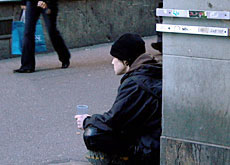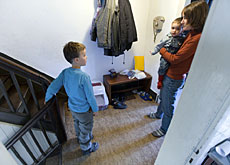Report reveals dangers of youth poverty

Poverty among children and young people is a social time bomb and largely a taboo issue, according to a report by a group of experts.
The Federal Commission for Children and Young People said on Tuesday that a string of urgent measures was needed. Nearly one in two recipients of Swiss social benefits is a young person.
The commission is calling for a nationwide plan of action and urging politicians – ahead of October’s federal elections – to treat the issue seriously.
Figures from 2005 show that almost 45 per cent of those receiving social aid were people under the age of 25.
“For me it is a really big problem… for example if we take people above the age of 65 they represent only 1.5 per cent, so it shows a very big discrepancy between young and older people,” Chantal Ostorero, who led the study, told swissinfo.
Among the groups most at risk are children whose parents are unemployed, those living in a single-parent family, children of immigrant parents or those who have more than two brothers and sisters, the report said.
Those most affected live in large urban areas, where one in ten young people between the ages of 18 and 25 is dependent on social aid.
Need for training
And 70 per cent of young adults receiving social benefits had not completed vocational training, which seriously hampered their future.
“It is important to give them training, that they finish it, and that they find a good job and stay in it,” Ostorero said.
The commission, which began to tackle the problem two years ago, considered that economic and social integration of young people was “vital for Switzerland’s future”.
To shed light on what it considered a “worrying reality”, the commission categorised children and young people as such rather than as members of a family which received social aid.
It has put forward a national strategy to combat poverty, which includes 55 measures aimed at prevention.
“For us, all of them are important because what we are calling for is a global strategy to fight this problem and to prevent poverty and social exclusion,” Ostorero said.
Government role
Among the measures suggested is the government taking more responsibility for education and doing more to help young people into the job market on a long-term basis.
The commission is also suggesting the creation of a national fund for vocational training. A tripartite body would manage this, with representatives from employees, employers and the authorities.
“It is time to put this problem issue at the top of the political agenda to redefine solidarity among the generations for the benefit of the young,” Ostorero said.
She added that ahead of the federal elections, it was important for politicians to take note of the report.
“They’re very often more concerned with other issues… We want to wake up the politicians in Switzerland to do something because otherwise the situation could be problematic later on.”
Healthier lifestyle
The commission’s vice-president, Anna Sax, favoured a healthier lifestyle for all, noting that children from poor families were more often malnourished or overweight than those from better off homes.
Sax said equal opportunities in health matters could be improved, with more emphasis on healthy lifestyles at crèches, kindergartens and schools. Where possible, parents should also be involved.
The obligatory three hours of sport at primary schools should be maintained or, better still, be expanded. Domestic science should also be kept.
She made a plea for education on how to become a consumer without running into debt, pointing out that about a third of people in the German-language region of Switzerland between 18 and 24 had debts.
swissinfo, Robert Brookes
A 2005 report from the UN children’s agency (Unicef) found that the proportion of children living below national poverty lines had risen in a majority of the world’s developed economies.
The lowest figures were found in Denmark and Finland with child poverty rates of 2.4% and 2.8% respectively.
They were followed by Norway (3.4%), Sweden (4.2%), Switzerland and the Czech Republic (6.8%), France (7.5%), Belgium (7.7%), Hungary (8.8%) and Luxembourg (9.1%).
The United States (21.9%) and Mexico (27.7%) were among the highest in the list, which included 26 members of the Organisation for Economic Cooperation and Development.
In April this year, the Federal Statistics Office said the number of working people between the age of 20 and 59 who lived below the poverty line had dropped between 2000 and 2005 from 5% to 4.2% or 125,000 people.
These figures were down due to a “robust economy”, it said.
But the Catholic charity Caritas argued that the figures were down because of a new definition of poverty.
It claimed one in seven people in Switzerland – that means up to one million – was living in poverty.

In compliance with the JTI standards
More: SWI swissinfo.ch certified by the Journalism Trust Initiative



You can find an overview of ongoing debates with our journalists here. Please join us!
If you want to start a conversation about a topic raised in this article or want to report factual errors, email us at english@swissinfo.ch.